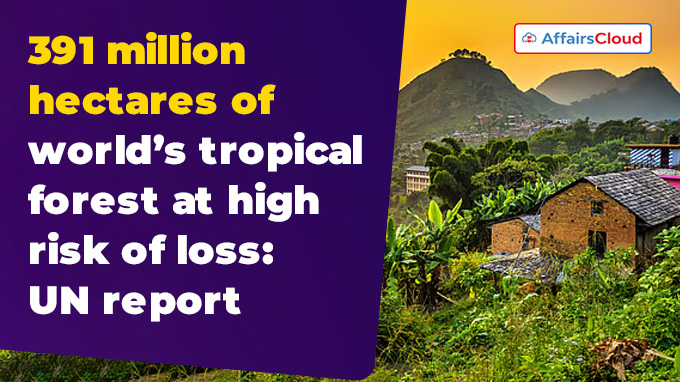In October 2025, the United Nation Environment Programme (UNEP) released a report titled “High-risk forests, high-value returns: A co-benefit assessments for decision-makers”, in which it highlighted that around 391 million (mn) hectares (ha) of tropical forests are at high risk of deforestation.
Exam Hints:
- What? High-risk forests, high-value returns report
- Released by: UNEP
- High-risk forests: It covers 391 mn ha
- Water Regulation: Retain 2.3 mn tonnes of nitrogen pollutants, prevent 527 mn tonnes of sediment, 10-14% regional rain recycled
- Food Security: Boosts nutritional needs of around 10 mn people
- Livelihood: Achieve 1GtCO2e, provide NTFPs, Help 25 mn people
- Climate Adaptation: Saves estimated USD 81 bn in annual GDP
- Commitment: UN-REDD Programme’s 2021-2025 strategy aims to realize 1 GtCO2e yr-1
Key Highlights
High-risk forests: These are areas with high carbon stocks, significant additional ecosystem services, and a high likelihood of deforestation.
- Together they cover about 391 mn ha of tropical forests, nearly one-fourth of the world’s total 1.6 billion (bn) ha of tropical forest area.
Purpose of the report: The report aims to identify where these forests are most threatened and where protection would deliver the greatest benefits.
- It provides data-driven insights to help policymakers and investors prioritize protection efforts that maximize climate and ecological benefits.
Water Regulation and water quality improvement
Keeping rivers clean: These high-risk tropical forests continue to prevent significant nutrient and sediment pollution from entering waterways.
- These protected forests annually retain approximately 2.3 mn tonnes of nitrogen pollutants.
Reducing Erosion: When forests are cleared, rain washes large amounts of soil into rivers, which can clog waterways, damage infrastructure, and reduce farming productivity.
- Protecting high-risk tropical forests can prevent about 527 mn tonnes of sediment from entering rivers each year, enough to fill around 150,000 Olympic-size swimming pools.
Moisture Recycling: Preventing deforestation in tropical forest areas helps sustain regional rainfall patterns, with an estimated 10-14% regional rain recycled locally by high-risk forests.
Food Security
Nutritional needs: The analysis shows that protecting high-risk forests would sustain crop pollination, which boosts crop yields equivalent to the nutritional needs of around 10 mn people annually.
- Across all pantropical forests, pollination-supported crop yields provide the equivalent of the nutritional needs of 18 mn people annually.
Sustaining Livelihood
Fuel and Livelihood: Conserving high-risk forests to achieve a 1 GtCO₂e (gigatonnes of carbon dioxide equivalent) annual emissions reduction target would secure annual sustainable supplies of approximately 111 mn tonnes of fuelwood.
- Forests provide non-timber forest products (NTFPs) such as fruits, nuts, medicinal plants, fibres, and bushmeat, which are harvested for household use and local trade.
- The analysis shows that 25 mn material-poor people depend on NTFPs
from these protected forests.
Climate Adaptation
Natural Disaster risk reduction: By stabilizing soil, regulating water flow, and buffering extreme weather, high-risk forests help prevent floods, landslides, and storms.
- Their protection saves an estimated USD 81 bn in annual GDP (Gross Domestic Product) losses by avoiding damage to infrastructure, farmland, and communities, thereby safeguarding both lives and economies.
Global Commitments
International climate frameworks stress the urgent need to protect forests.
REDD+: The UN’s Reducing Emissions from Deforestation and Forest Degradation (REDD+) framework supports the Paris Agreement by working with developing countries to implement measures that reduce
human pressure on forests resulting in greenhouse gas emissions.
- The UN-REDD Programme’s 2021-2025 strategy aims to realize 1 GtCO2e yr-1 (gigatonnes of carbon dioxide equivalent) of forest-based GHG emission reductions and enhanced removals.
About United Nation Environment Programme (UNEP)
The UNEP is the UN’s leading global authority on the environment, driving transformational change on the triple planetary crisis: the crisis of climate change, the crisis of nature, land and biodiversity loss, and the crisis of pollution and waste.
Executive Director (ED): Inger Anderson
Headquarters: Nairobi, Kenya
Established: 1972





